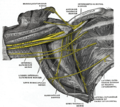| Axillary artery | |
|---|---|
 Axillary artery and its branches—anterior view of right upper limb and thorax. Upper and lower limits labeled. | |
 The pectoralis minor muscle is used as a landmark for dividing the axillary artery into three parts. | |
| Details | |
| Source | Subclavian artery |
| Branches | Superior thoracic thoracoacromial lateral thoracic subscapular anterior circumflex humeral posterior circumflex humeral continues as brachial artery |
| Vein | Axillary vein |
| Supplies | Axilla |
| Identifiers | |
| Latin | arteria axillaris |
| MeSH | D001366 |
| TA98 | A12.2.09.002 |
| TA2 | 4616 |
| FMA | 22654 |
| Anatomical terminology | |
In human anatomy, the axillary artery is a large blood vessel that conveys oxygenated blood to the lateral aspect of the thorax, the axilla (armpit) and the upper limb. Its origin is at the lateral margin of the first rib, before which it is called the subclavian artery.
Contents
After passing the lower margin of teres major it becomes the brachial artery.










